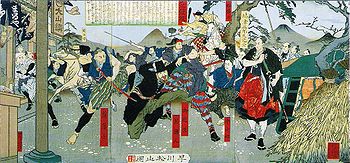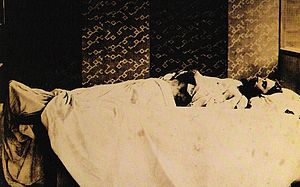- Namamugi Incident
-
 The Namamugi Incident, as depicted in a 19th century Japanese woodcut print. Charles Lennox Richardson is at the centre of the scene.
The Namamugi Incident, as depicted in a 19th century Japanese woodcut print. Charles Lennox Richardson is at the centre of the scene.
The Namamugi Incident (生麦事件 Namamugi-jiken) (also known sometimes as the Kanagawa Incident, and as the Richardson Affair) was a samurai assault on foreign nationals in Japan on September 14, 1862, which resulted in the August 1863 bombardment of Kagoshima, during the Late Tokugawa shogunate. In Japanese the bombardment is described as a war between the United Kingdom and Satsuma domain, the Anglo-Satsuma War.
Contents
Course of events
 Body of Charles Richardson, 1862.
Body of Charles Richardson, 1862.
Four British subjects (a Shanghai merchant named Charles Lennox Richardson, two other Yokohama-based merchants, Woodthorpe Charles Clark and William Marshall, and Mrs. Margaret Watson Borradaile) were travelling for a jaunt on the Tōkaidō road through the village of Namamugi (now part of Tsurumi ward, Yokohama) en route to Kawasaki Daishi temple in present-day Kawasaki. The party had departed the treaty port of Yokohama at 2.30 pm by boat, crossing Yokohama harbour to Kanagawa village, to meet up with their horses, which had been sent ahead.
As they passed north through Namamugi village, they encountered the large armed retinue of Shimazu Hisamitsu, the regent and father of Shimazu Tadayoshi, the daimyo of Satsuma, heading in the other direction. The party continued to ride along the side of the road without dismounting until they reached the main body of the procession, which occupied the entire width of the road. In Japan, samurai had a legal right to strike anyone who showed disrespect (See Kirisute gomen). However, British nationals were protected by Extraterritoriality under the Anglo-Japanese Friendship Treaty and were exempt. Richardson, leading the Britons, rode too close to the procession and was slashed at by one of the Satsuma bodyguards. The two other men were seriously wounded (Mrs Borrodaile was not physically harmed), and they rode away as fast as they could, Richardson eventually falling from his horse, mortally wounded. Hisamitsu gave the order for todome - the coup de grâce - to be given. Richardson's grave is in Yokohama in a private plot near the Yokohama Foreign General Cemetery, between the later graves of Marshall and Clarke.[1]
The case of Eugene Van Reed, who had dismounted and bowed before a daimyo's train, was instanced by Shimazu's supporters who later said that the insolent attitude of the Britons (who did not dismount) caused the incident. Van Reed's conduct appalled the Western community, who believed that westerners should hold themselves with dignity before the Japanese, being at least the equal of any Japanese person. There is no evidence to support later suggestions that Richardson whipped Chinese while horseback riding in China, though according to the Japan Herald "Extra" of Tuesday 16 September 1862, he had been heard to say just prior to the incident, "I know how to deal with these people".
Consequences of the Namamugi Incident
 Poetic monument of Namamugi Incident in Yokohama.
Poetic monument of Namamugi Incident in Yokohama.
The incident sparked a scare in Japan's foreign community, which was based in the Kannai district of Yokohama. Many traders appealed to their governments to take punitive action against Japan. Britain demanded reparations from the Government (£100,000, eventually paid) and from the Daimyo of Satsuma (together with the arrest, trial and execution of the perpetrators, which never took place). Satsuma prevaricated and Britain eventually engaged Satsuma a year later in what subsequently became known to the Japanese as the Anglo-Satsuma War. A squadron went to Kagoshima, capital of the Satsuma domain to demand reparation for the Namamugi Incident. Meeting further prevarication, they seized several Satsuma vessels as hostage against payment, and were unexpectedly fired on by Satsuma forts. The squadron retaliated, and the naval bombardment of Kagoshima ensued. This claimed five lives among the people of Satsuma (which had largely been evacuated prior to the unheralded attack on the British squadron), and 11 lives among the British (including, with a single cannon shot, both the Captain and Commander of the British flagship HMS Euryalus).[2] Material losses were substantial, with around 500 houses burnt in Kagoshima, and three Satsuma steamships sunk. The conflict caused much controversy in the British House of Commons, but Acting Vice Admiral Augustus Leopold Kuper's conduct was eventually commended by the House. Kuper was promoted Knight Commander of the Most Honourable Order of the Bath in 1864 "for his services at Kagoshima".
Satsuma admired the superiority of the Royal Navy and sought a trading relationship with Britain as a result. Later that year, they paid the £25,000 (GB£16,000,000 in 2011 pounds)[3] compensation demanded by the British Government, borrowing (and never repaying) the money from the bakufu - the shogun's government that had only five years to run before being replaced by the restored government of Emperor Meiji.
The incident was the basis of James Clavell's novel Gai-Jin.
See also
- Anglo-Japanese relations
- Anglo-Satsuma War
Notes
- ^ Rennie. The British Arms in North China and Japan page 273
- ^ The British victims were caused by Satsuma gunnery as well as accidents due to the imperfect Breech-loading guns developed by the English engineer William George Armstrong.
- ^ Measuring Worth, Relative Value of a UK Pound Amount - average earnings, retrieved on the 7 May 2010
Further reading
- Satow, Ernest. A Diplomat in Japan, Tuttle (1921). ISBN 4-925080-28-8
- Rennie, David. The British Arms in North China and Japan. Adamant Media Corporation. (2001) ISBN 1-4021-8184-1
- Denney, John. Respect and Consideration: Britain in Japan 1853 - 1868 and beyond. Radiance Press (2011). ISBN 978-0-9568798-0-6
Coordinates: 35°29′40.1″N 139°40′18.3″E / 35.494472°N 139.67175°E
Categories:- 1862 in Japan
- Diplomatic incidents
- Edo period
- History of the foreign relations of Japan
- Yokohama
Wikimedia Foundation. 2010.

